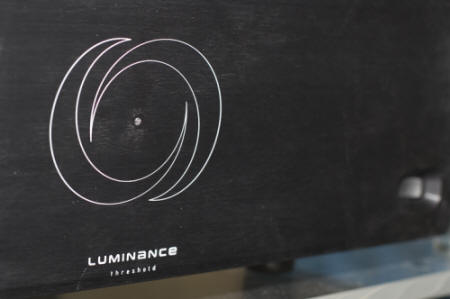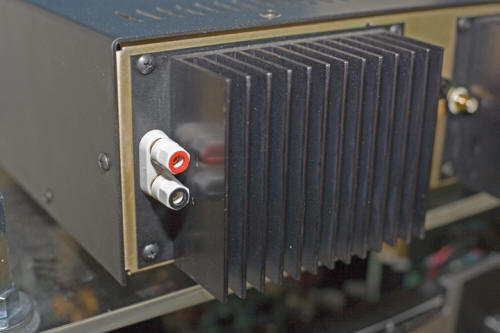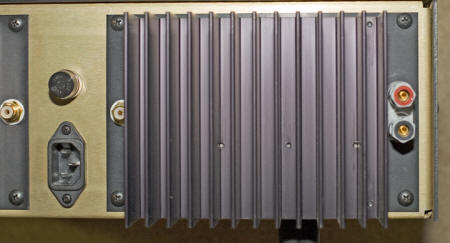You are reading the older HTML site
Positive Feedback
ISSUE
25
may/june
luminance audio
KST-150 amplifier
as reviewed by Ed Morawski and a bit or two from Dave Clark

|
ED MORAWSKI'S SYSTEM:
LOUDSPEAKERS
ELECTRONICS
SOURCES
CABLES
ACCESSORIES
|
Fastest car on earth, fastest man alive, and fastest gun in the West, and now we have the Fastest Amplifier in the World! Luminance Audio (www.luminanceaudio.com/Home.htm) makes this statement about their new KTS-150, which has a slew rate of 250 volts per microsecond (compared to 100 volts for most "flagship" amplifiers). Luminance is a new company, co-founded by Steve Kaiser, Mike Tseng, and Rick Schulz of Virtual Dynamics. The KTS-150 is rated at 150 watts per channel, and incorporates Schulz's Speed of Light Technology. Its slew rate makes it inherently fast—no, let's say super-fast. That question is: Does this make an audible difference?
I feel that my system is now performing at such a high level that all audiophile-grade components sound good in it. Most high-end equipment is pretty darn great these days, and despite what the conspiracy theorists on the Audio Asylum and Audiogon forums think, audio reviewers tell the truth. If something sounds really bad, I would not hesitate to say so, but I just don't run into really bad stuff. By now, it's pretty difficult to screw up an amplifier circuit, so the main issues reviewers face are pieces of equipment that are not special or just plain fail. Failures are not surprising, by the way, since a lot of audiophile gear is produced in very low numbers, and the higher the price, the more likely that it is custom-made. The KTS-150 amplifier is a case in point. The review sample looked like it was part of an early production run. It also exhibited some audible hum, enough to be irritating—please note that I'm reporting this! I was able to defeat some of the hum by using a cheater plug, but Luminance has some work to do.
Does this make the KST-150 a piece of junk? No. In fact, it sounds pretty good, which brings up another sore point. I have read a lot of harping on the internet forums about reviewers going over the top in their positive comments. What do you people want? You get upset when there are no bad reviews, and even more upset when there are good ones. My goal when I got into this game was to provide information about equipment that most audiophiles would not be able to hear for themselves. That's why I rarely report on popular components, since you can probably hear them at your local dealer. When I audition a piece of gear, I report on its flavor, and attempt to compare it to a component you might be familiar with. In other words, I provide a point of reference. I will tell you if I love it, and will say so as a music lover, not because of advertising or the vast sums of money I'm getting paid (ha!).
The Luminance KTS-150 is not going to win any industrial design contests. It looks pretty plain. I used to think function-over-form was the way to go. After all, it's the sound that counts, right? Still, at this price ($3000), I think the owner deserves a little form for his or her money—look at Classe, Krell, Levinson, Plinius, not to mention DK Design. Next comes the ergonomics of the KST-150. Again, it appears that Luminance was concentrating on engineering instead of user convenience. The cheap-looking plastic binding posts on the back panel are way too close to the heat sinks. I couldn't get my fingers around the posts to tighten them, and had to use a wrench. Even that was difficult. Pray that your spades are not too long, as they may actually touch the heat sinks. In fairness, there may be a legitimate engineering reason for this—perhaps it is meant to ensure the shortest possible signal path between inputs and outputs.

I also noticed that the RCA inputs were not properly marked—both were white. Is this nit picking? When I see this kind of thing in a component I've purchased, I wonder if I have spent my money wisely. I think Luminance really needs to step it up a notch to set themselves apart in a very crowded market. How about the sound? I'm getting to it. The system in which I listened to the KST-150 consisted of a BAT VK-31 preamp, a Musical Fidelity A308 CD player and Tri-vista 21 DAC, Olympic Audio speakers, and VooDoo cables.

I let the KTS-150 settle in for 24 hours with the system playing at low level. I had been informed that the amplifier had already been burned in, so I figured that was plenty. I began my listening with Mirabilis by the Mediaeval Baebes, a chorus of young ladies singing Celtic tunes. The sound of the KST-150 was hard to pin down. Although the highs and lows were extended, I felt like I was sitting in the last row of a concert hall, rather than in my usual position in the front row. While this was not a bad thing, it took some getting used to. I also noticed that the soundstage was much higher than usual. For the next several weeks, I played many CDs. The KTS-150 seemed to favor classical and jazz music without vocals, which sounded rather thin. Eiji Oue and the Minnesota Orchestra's rendition of Rachmaninoff's Symphonic Dances was excellent, but Diana Krall's Look of Love did nothing for me.
The KTS-150 exhibited no distortion or clipping at any level. I played it extremely loudly on one occasion (0dB on my preamp), and heard no strain or congestion. At low levels or high, the Luminance sounded transparent and neutral. It was the polar opposite of dark. As a reality check, I reinserted my Musical Fidelity A308 amplifier into the system. The first thing I noticed was that the silence was deafening. The A308 was so quiet compared to the Luminance that I almost dreaded the thought of reinstalling the KST-150. The two amplifiers are very different beasts. The A308, which retailed for $4000, has nearly twice the power of the Luminance amp, and the difference was quite evident. The A308 is much richer and more textured through the midrange, and it makes voices come alive. I had considered the KTS-150 pretty good in the bass until I compared it to the A308, which was the clear winner on this score.
After reinstalling the KTS-150, I realized that I would have to come up with a new descriptor for it. "Neutral," "reserved," and "laid back" didn't cut it. The Luminance sounds sterile, yet not polite. It's like a capable professional who stands in the corner at a dinner party, yet has a huge ego when you finally talk to him. Therein lies the problem—once you hear the KTS-150, I'm not sure you will be moved to get to know it better. I, for one, was not. It somewhat resembled the Son of Ampzilla. I think it is much more neutral, but it retains much of that amplifier's dynamic character. Is it musical? That depends on your definition of neutral. Many of my family members are musicians, none of them classical musicians, and none too polite, either. They probably wouldn't appreciate the Luminance.
The KST-150 sounded restrained and dry—even standoffish—on CDs like Tift Merritt's Bramble Rose and Antigone Rising's From the Ground Up. Although nothing was over- or under-emphasized, and the details were very, very clean, I found the sound too recessed. In fact, it was an effort to listen to the KTS-150 after listening to the A308. The hum was particularly disconcerting, though I'm certain that it disturbed me more than it would most listeners, since my listening room is small and I sit very close to my speakers. I continued trying various recordings, including Rimsky-Korsakov's Scheherazade and Stravinsky's L'Oiseau De Feu, a sweeping orchestral piece that I hoped would bring out the Luminance amp's best qualities. Here again, the hum was so evident that quiet passages were completely overcome, and the recording was ruined.
I found the KTS-150 to be a capable amplifier, one that I could not drive hard enough to clip or distort. It has good separation and imaging. Other than the ergonomic issues I have mentioned, it performed very well from a technical standpoint. I did find fault with the sonic character of the amp, but that is entirely my opinion. Many listeners will find the KTS-150 extremely neutral. If you listen to classical music and jazz, and Luminance can tame that hum, I'm sure you will be pleased with the KST-150. If you like transparent, fast, extremely neutral sound, the Luminance may give you exactly what you seek. Ed Morawski
Some Additional Comments from Dave Clark
I also had the KTS-150 amplifier for a week or so (prior to Ed's audition) and would like to add my 33 cents worth to what he has written.
Yes, the amplifier did have an audible hum that can be reduced considerably with the use of a cheater plug. But since I sit much father away in a much larger room, this was not a deal breaker. On the other hand, it is now a moot point as the manufacturer has addressed the issue in this amp and future production. They found the cause and have re-done whatever they needed to do so all future amps will not hum. I am assuming that if you already own one, they can address it as well—contact them. Other than the hum issue they felt the amp was working as it should.
Yes, the ergonomics of the amp are not the best. Hooking up speakers and all is a real pain in the arse as there ain't a whole lot of room on the rear to work with. Come on... I realize that the heatsinks go where they need to go based on the circuit and layout, but the binding posts and RCAs are a real bitch to deal with if you have manly speaker cables and interconnects like us real manly audiophiles.
But, and this is a big BUT... here the KTS-150 sounded rather okay. No, it is not a price beater where it made me question other amps at or above it dollar-wise. But it did sound good, good like the best from Adcom or what one can hear from other similarly designed solid-state amplifiers. Nothing spectacular mind you, but the KTS-150 offered a nice balance of clichéd audio-virtues—never possessing, sound-wise, too much of that or not enough of this. It is quite solid and dynamic, offers very good extension at either end with little to complain about, and well, the KTS-150 played well with others.
It did not though make me want to have one (I do know a golden-eared audio-nut who found it to be the bees knees with his original Quads and as such, just has to have one!). It was nice and all, but it never really did enough overall to draw attention to either itself or to what it was doing to the music. The first is a good thing as one should not be listening to a component, but the second is where I found fault as music became more part of the background and not as involving as we are used to here in our audio world. Even so, the KTS-150 is one of those products that can serve you well. It gets out of the way by being not so much a ho-hum product, but one that is competent and consistent. Flashy it ain't. If this is what you are after, give one a listen. I do feel that perhaps we did not have the right system/components or perhaps wants for the KST-150 to show its true mettle. This is not being said to qualify why my comments (or Ed's for that matter) are not a rave. The simple truth is that this amplifier did not sound nearly as good as I as expecting, based on my previous experience. I did hear the KTS-150 at CES and feel that that audition, to far exceed what was heard here. Different system completely and no doubt voiced to reveal the best that each part had to offer. Go figure. Even so, this is a good product offered at a decent price.
KST-150 amplifier
Retail: $3000
Luminance
web address:
www.luminanceaudio.com
Ed is currently involved in the manufacturing of Olympic Loudspeakers.
